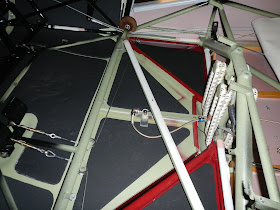Once in Northwest Wisconsin, it's easy to find Thunder Bay. Just follow the long... long shoreline.
Successful test of the aux tank!
Fuel burn was about 5 gallons the first hour and about 4.25 per hour thereafter using the mixture control!
After about 12 hours of air time things looked good under the hood.
I opened things up a bit to take a closer look.
Re-torqued the exhaust nuts again and had a general look around.
I added no oil during the trip or to about 15 hours flight time. It was down less than half a quart. At that point I dumped the oil and pulled the screen. All looked good.
Incidentally I ran Shell 15w50 (no mineral oil) right from the off. I changed the oil at 15 hours given there is only a screen, but it probably wasn't necessary.
I'll reuse the low-time oil in my Jeep!
I noticed a little rubbing of the cowling against the bottom of the air box so did a little forming to increase clearance.
The air filter housing had also been touching the shroud. Far too much work went into fabricating that so I re-positioned the filter housing and added some teflon tape to ensure the problem is fixed.
Smooth air on the way home allowed for note-taking on trim. One issue was the turn and slip indicator wasn't level.
I also put another half turn in the right wing strut and put a link in the left rudder spring, which has it pretty good now at cruise power.
And to save my back, given the stock tailwheel doesn't caster, I made a tow bar.
Oh and I forgot to take photos during installation of the ailerons. I had used AN4 bolts, even though at some point I had purchased the clevis pins that are supposed to be used. Thanks to Tom (3Dreaming from the Taylorcraft forum) at OSH for politely pointing out the error of my ways.
Anyway I used some locktite to ensure the pins don't rotate and also serve as witness marks.
After trying different options for the internal com antenna, I decided to install a basic whip antenna. The dipole antenna worked perfectly for some frequencies but I experienced blinds spots on 118.1Mhz (our Tower frequency) for example.
The whip eliminated the blind spots, but also picks up more noise from the A65. I haven't yet given up on the internal antenna option but this works for now.
Apparently the closer the antenna is to the engine, the louder the ignition noise!
And I started tidying up the shop.
All those parts I fabricated plus spars and leading edges!
That's it for now. Just finished renewing my instrument rating and it's time for a break from light aircraft for a few weeks.
We're off to the UK to visit friends and relatives and then Italy to do the tourist thing.











Scott, Thank you for taking the time to have done the blog and shown the work as it was done. I appreciate yours and the many others on the Taylorcraft forum so very much. I hope you continue to communicate and forward to that restoration book you mentioned. Clark F
ReplyDeleteI also wanted to say your craftsmanship and the final aircraft are very admirable and a tribute to the time and effort invested. Clark
ReplyDeleteThank You Clark. Your comments as most appreciated
DeleteBeautiful job restoring your Taylorcraft. I had many enjoyable hours flying with my friend Ken in CF-DEP after he purchased it in somewhat derelict condition from an owner at Markham airport. It must have been a monumental task to get it in the condition it is now.
ReplyDelete